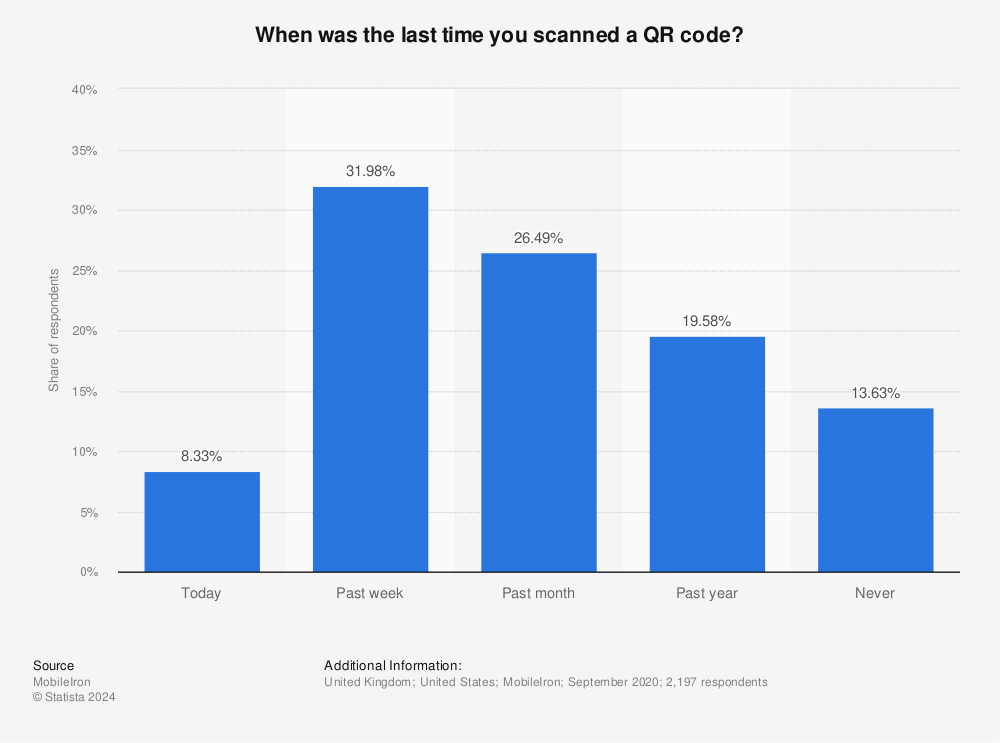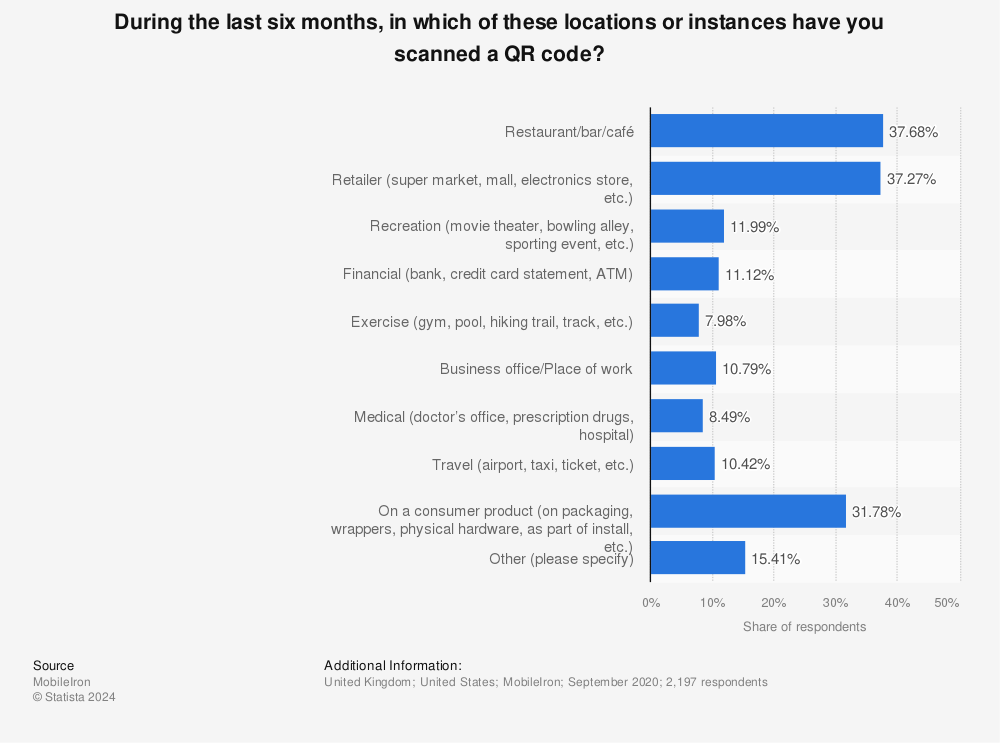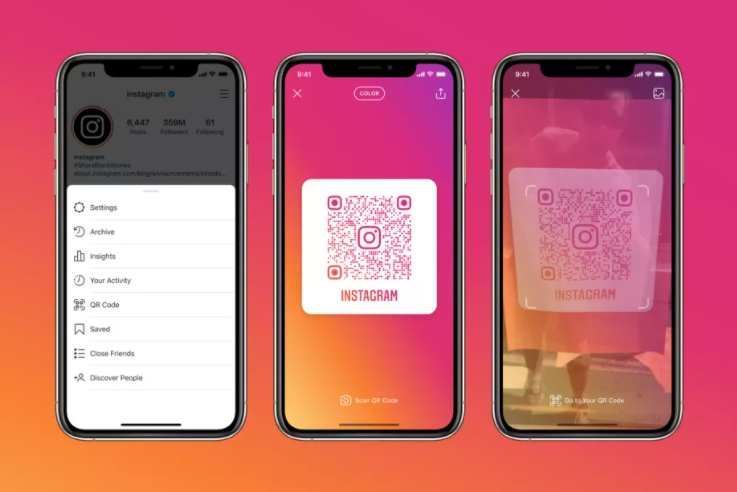QR codes have come a long way since they’ve been introduced back in 1994. What was once used to track automative parts’ inventory has evolved as a strategic marketing tactic. These standard black-and-white barcodes can be customized branded designs.
The 2020 pandemic is credited with helping bring the QR code back to marketing use. With a scan of a code, people can learn everything about a product, make a payment and even write a quick Yelp review.
What are QR codes?
Quick Response (QR) codes were created to store a lot of data in a small 2D matrix barcode. But unlike barcodes, QR codes can store far more information (more than 7,000 characters) and be read more than 10 times faster. The QR code was officially released by two engineers at Denso Wave in 1994 and first used by Japan’s auto industry.
The other unique feature of a QR code is that the specifications of it were intentionally made to be publicly available. Because of this, being added to the ISO standard in 2000 and smartphone apps and cameras with the capability to read them, the codes were easy to create and accessible to many people around the world.
When creating codes, it’s important to know that the more information you are encoding, the larger and more complex the code will be. These codes are also permanent for as long as the landing page or action is available. On the consumer’s end, though, all they need is a smartphone that has a reader in the camera.
Are QR codes still relevant for business marketing?
When created and executed well, QR codes can be incorporated or centered in a marketing campaign. They can also be used daily, such as for a payment option. Two different kinds of QR codes exist: static and dynamic. As implied, static codes are hardcoded once they’re created and are best used for tasks like sharing an email address or contact information.
Dynamic codes don’t store the data but instead redirect the scanner, much like when you share a link to a webpage. But they’re not limited to only webpages. Dynamic QR codes can also lead you to a coupon, event page, a PDF and even SMS text creation. If needed, you can change up the contents or type of dynamic code without regenerating a fresh code. This makes dynamic codes the best for marketing campaigns.

According to a September 2020 survey of US and UK customers, 31.98% of those surveyed had scanned a QR code within the last week.
And when asked about where they scanned the QR code, three locations stood out:
- 37.68% have scanned at a restaurant, bar or cafe
- 37.27% scanned at a retailer
- 31.78% scanned on a consumer product.
Because of their no-touch feature in limiting contact between people, QR codes have been more recently favored and used by businesses.
How to use QR codes in marketing
There are many ways to incorporate QR codes into your marketing efforts. Here are just a few to get your brainstorming juices flowing.
Share your social media accounts
Many social media platforms offer you the ability to customize your account’s QR code. When scanned, the person is led directly to your profile, where they can then hit the button to follow you. These codes can also be printed out to be used in-person to bridge the digital and retail location gap.

Instagram’s QR code is available in your profile and has options to customize: emoji, color and selfie. Each platform has their own take on the account QR code, often incorporating brand colors and embellishing the design.
Another option is to create a landing page where all of your social media accounts are linked. A single scan lets the consumer choose which accounts to follow.
Post a coupon
If there is one thing that everyone loves, it’s a good deal. QR codes can be posted on social media, in an aisle at a retail store or passed out in flyers. After scanning the code, the consumer is led to a coupon that’s available online or in an app.

In this example, Target encourages buyers to scan the code to activate the deal in their Target app account. As a shopper, you no longer need to cut out coupons or remember to bring them to the store. A coupon QR code is a great way to bring in new customers or increase your brand loyalty.
Share a food or service menu
The restaurant industry took a huge hit in 2020 and owners got creative on how to navigate a touchless environment. Instead of handing out paper or reusable menus, use a QR code to redirect diners to a webpage of all your menu items.

In this example, beer garden Hoptinger uses signage inside to provide a link to their menus. And because the scan only leads to a webpage, Hoptinger can then update the page with new menu items without generating new codes.
Ask for reviews or feedback
Reviews are of utmost importance for many industries but getting them can feel challenging at times. One of the strategies for increasing your review count is to outright ask for reviews.

Encourage reviews by handing out cards like the one above, posting them on signage on doors, tables or menus, or sending them through email. The code takes the customer to the survey or review site to make it easier for them to leave their feedback.
Provide product information
There’s only so much information you can put onto a product package before it appears cluttered. Use QR codes on product packaging to encourage customers to learn more about a product. They can link to anything from a promotional video to a quick start guide to how to assemble the product.

Using QR codes in packaging like those above cuts down on potential paper waste and frees up space for other designs. In addition, if these take you to something like a quick start guide, you can change up the guide without having to reprint thousands of updated booklets.
Run a giveaway
Besides a good deal, giveaways also get people excited is a good giveaway. If you’re looking for a way to encourage giveaway participation, make it easy for people to join in. In the past, giveaways have lived on a single platform like an Instagram contest or asked people to visit a URL to sign up. But asking people to remember a URL means you’re relying on memory. Scanning a QR code to lead directly to the entry form is fast and simple.

In the example above, you can see how the QR codes were incorporated into the packaging as a contest entry option.
How to track & measure QR code success
It’s easy to create your own custom QR code thanks to readily available, free online QR code generators. Some services allow for basic data QR codes while others lock the features behind a pro plan. For QR codes that link to a website, generating a specific shortcode will let you track the clicks.
But if you’re serious about using QR codes in your multichannel marketing campaigns, then it’s best to invest in software that provides data beyond the number of scans. You’ll be able to learn where the scanners are based, what operating systems they use and scans by date. Much like social media advertising, QR code data is tracked and displayed in real-time, offering you the chance to possibly tweak campaigns as they are run.
QR code recap & best practices
QR codes have seen a resurgence lately. They’re convenient to scan, the designs can be customized to be more visually appealing and they’re inherently a contactless technology. For businesses, it’s just as easy to incorporate QR codes into every part of the marketing funnel as it is to generate your own code.
When you’re starting out on using QR codes for business marketing, there are a few best practices to keep in mind:
- Add a call-to-action: Slapping a code by itself onto anything won’t be beneficial without context. What is the code for? Add a call-to-action near the code. It could be part of a border surrounding the code or a simple line of text above.
- Have a purpose: Just because you read about QR codes doesn’t mean you have to use them. Make sure that you’re using codes to aid in your marketing or to smooth out some customer experiences, not because it’s an emerging marketing trend.
- Incorporate into a design: Let’s admit it: the basic black-and-white QR code square is not the most visually appealing design out there. Dress it up by blending it into an existing design and adding your own brand spin to it. Again, notice how, in an example above, Arsenault uses their brand’s navy color as the background to their QR code.
- Track the codes: Marketing campaigns are useless if you don’t have the data to back up the success. Be sure to check in periodically on your codes to see if the campaign is successful.
Feeling ready to incorporate QR codes into your marketing but don’t know where to start? Try it out with your content. Take a look at the different types of social media content you can create to incorporate QR codes for and be armed with data.
The post How to use QR codes effectively in 2021 appeared first on Sprout Social.